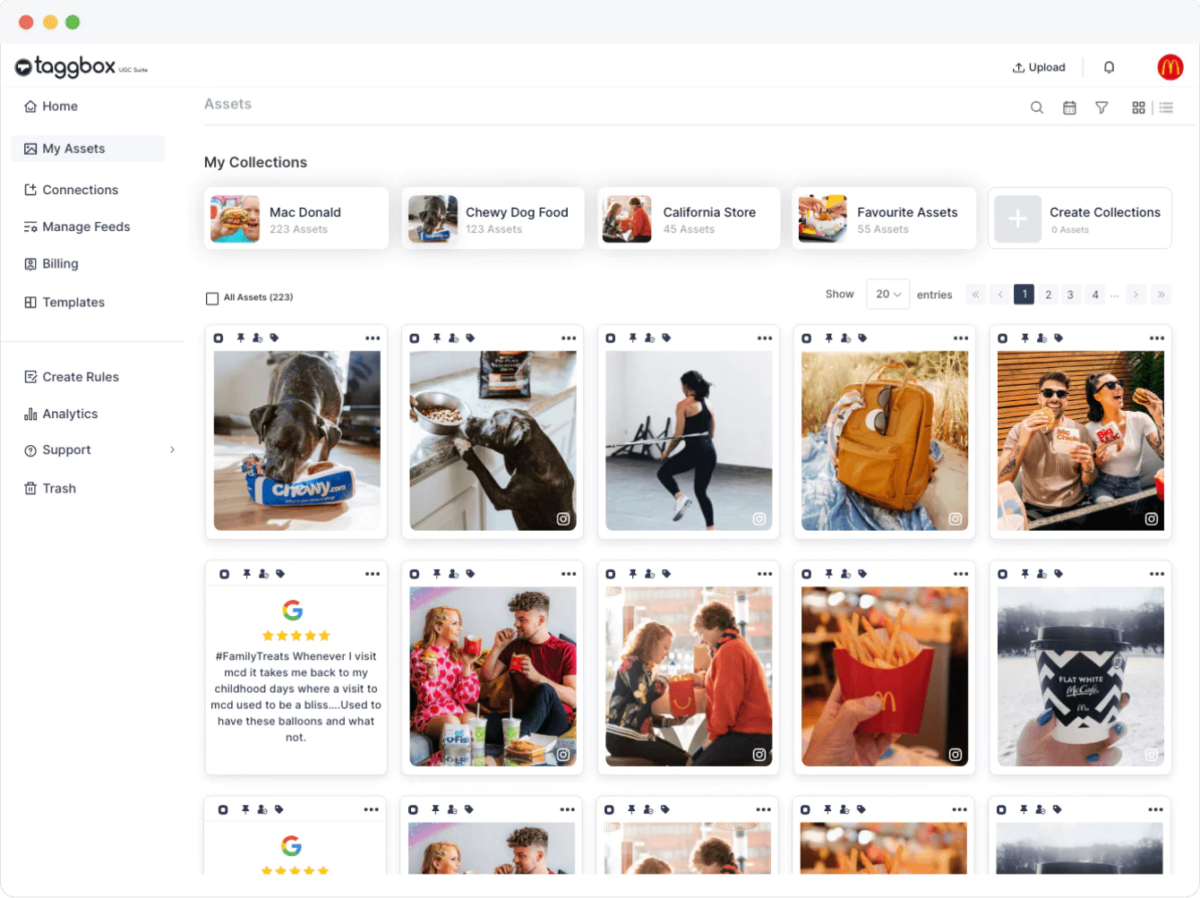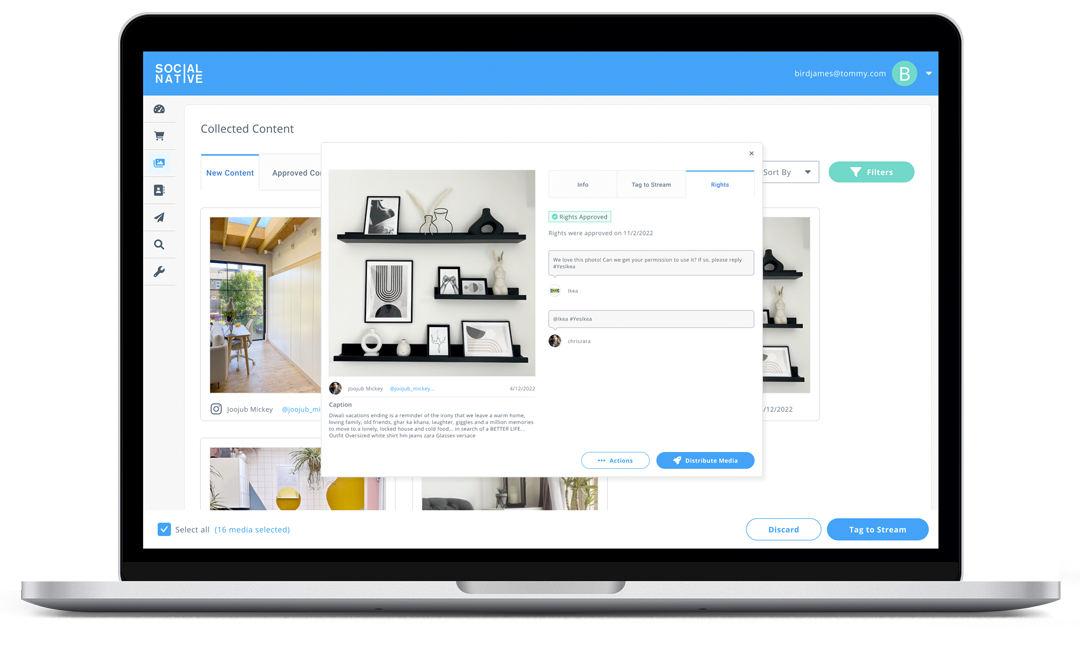
The Top 13 UGC Platforms to Empower Your Content Marketing in 2025
These days, it isn’t enough to crank out a bunch of branded content, put it on the Internet, and hope for the best. There’s too much competition in almost every industry and across major keywords for websites to perform well just because the content is great. Even carefully crafted traditional content often struggles in today’s environment, especially when it comes to social media.
Because of the shift away from mass-produced content made by brands, user-generated content has become more important than ever. However, finding users who are willing to create these items can be difficult, especially if your brand doesn’t have many customers or if you need to reach out and start developing relationships with a multitude of content creators. Fortunately, a UGC platform can help you achieve your goals.
What is UGC (user-generated content)?
User-generated content is any kind of web-based content that was created by an end user rather than a brand. One of the original UGC types is the customer review, as you see on Amazon or Yelp. These help potential customers decide if something is the right product for them. Nowadays we see this type of testimonial in the form of an Instagram post, TikTok short video, or even a longer YouTube video.
That’s why today we think of UGC as including anything that individuals who don’t work for the brand produce about the brand. These individuals could be influencers, casual customers, or someone who’s simply an end user. The content can be written, photographic, video, and more. The options are truly endless.
What are the Benefits of UGC?
While it’s easy to think that brands should always have complete control over their marketing and branded content, that’s unrealistic these days. Not only is it impossible to keep people from producing and posting content, but it isn’t in your company’s best interests to do so. Rather, you should leverage the power of a UGC platform to elevate your marketing.
We all know that authenticity is more important than ever. People are tired of the “canned” marketing messages that have severe bias. UGC helps cut through the noise by giving people a window into how everyday users of a product find it to be useful.
Similarly, UGC boosts the level of trust people have in a brand. Having ordinary people say that the product is great has a lot of weight in an increasingly competitive world. Even better, the use of a UGC platform will help you reap all the benefits of this content at an affordable price. End users often don’t charge a lot of money for the content.
Not convinced yet? The diverse and creative content you’ll get from users is something you can’t get from any professional ad agency or brand studio. Everyday people look at your brand differently, and they don’t have the branding pressures of an in-house vendor. Best of all, there’s ample evidence that UGC helps to boost sales in ways that nothing else does.
The Top 13 UGC Platforms to Check Out
As you can see, your brand can significantly benefit from user-generated content and influencer marketing. However, especially if you have a small team, the process can be challenging. Finding the right people, negotiating contracts, and monitoring performance all take valuable time. However, a UGC platform can help you with some or all of this process.
1. Yotpo

Yotpo is an all-in-one platform for customer retention. It has a large suite of tools, including email marketing, loyalty programs, and more. While they don’t say a lot about the UGC platform feature, it involves letting people submit pictures and other visual assets to your company, then posting them. You can offer some loyalty rewards in return, as you could with some other engagement actions.
2. Tint

Tint is another multipurpose marketing platform. However, it’s focused on just social media marketing. If you want to market on TikTok, Tint is the only UGC platform that’s compatible right now. Feature-wise, the system works on a mixture of content curation and AI-based filters.
Your first step is to passively collect UGC from social media profiles. Then, Tint’s algorithms will curate the best. From there, you can get the rights from inside the platform, make changes for branding, and publish it in your marketing campaigns. Since Tint works across platforms, there are many possibilities.
3. Taggbox

With Taggbox, you not only get a UGC platform that lets you source and prepare UGC for your campaigns, but you also get analytics data that can help you track and improve results over time. This analytical function means that you don’t have to use your other marketing tools to track what this one is accomplishing. However, you may still want to integrate datasets to make your life easier.
Another feature of Taggbox to consider is that you can integrate UGC into a variety of different campaigns, and not just social media. For instance, you can add UGC to emails, websites, and other media as appropriate and allowed.
Further Reading: What is a UGC Creator? And How Do I Become One?
4. Pixlee TurnTo

Pixlee has the same core features as other UGC platforms we’ve discussed so far. However, it goes further than just UGC shared for free. That is, you can do influencer marketing and ratings or reviews. Both of these are a kind of UGC, but they are used differently. Influencer marketing is a method whereby you compensate someone with significant social media influence to create content on your behalf. And as I’ve said before, unsolicited UGC can be a sign that someone loves your brand and might be interested in paid collaborations.
Pixlee works similarly to other platforms in that it helps automatically identify UGC and choose the best to become brand assets. The platform works on several social media networks, including TikTok, and you can use UGC from one network for a campaign on a different one (with permission).
One of the better features of Pixlee is that you can directly link your products in UGC to your products on a website. This is especially useful for e-commerce brands, where products can often look similar. Plus, this technique helps build some buzz a bit faster.
Further Reading: Why UGC Ads Are the Future of Advertising (and How to Use Them)
5. Social Native

Formerly known as Olapic, Social Native is a full-service UGC platform and influencer marketing tool. Social Native does all of the standard UGC-related tasks, but it’s also capable of handling the fulfillment and payment aspects of influencer marketing.
Is Your LinkedIn Working?
Just released: my new book to help professionals, entrepreneurs, and business owners maximize LinkedIn for real growth.
With years of LinkedIn expertise, Maximizing LinkedIn for Business Growth offers actionable steps to build your brand, expand your network, and drive results.
Start leveraging LinkedIn like never before—grab your copy now! Click the cover or button below to buy on Amazon.
Arguably, the most valuable aspect of this platform is its ability to do most of the work automatically. While humans must approve influencers and content creators, they’ll do it from a list of people that were identified by the AI-based vetting tools.
Here’s another difference. So far in this list, Social Native is the only one that lets influencers apply to a proposal. This way, you aren’t stuck with only the options served to you by the platform.
Further Reading: 21 Definitive Digital Marketing Platforms
6. Bazaarvoice

Small businesses have different needs from their larger competitors, especially on social media. Bazaarvoice knows this, and so their UGC platform is purpose-built for small and medium-sized businesses. One of the distinctions is that this platform gathers product and business reviews from around the web. This is somewhat different from other platforms in that the others mostly focus on social media.
However, Bazaarvoice is more than just content gathering. Rather, its tools help you encourage brand engagement and content creation, so your customers can become part of your success. And finally, for e-commerce brands, Bazaarvoice helps integrate UGC, including reviews, into your product pages. This helps people decide if your product is right for them and hopefully make a purchase.
Further Reading: 15 Social Media Content Ideas to Increase Engagement
7. ShortStack

If you think UGC is fun, how about a UGC platform that lets you make it a contest? ShortStack pairs the power of UGC with the fun of contests. In this case, users submit UGC in exchange for a contest entry. You can also collect lead information. Have an influencer lead the contest, or let the computer choose a random winner. No matter how you do it, you’ll have fun and get a lot of engagement.
The best part? You can do most of the setup with a quick template within the platform itself. There’s very little effort required.
Further Reading: 24 Ways How to Improve Online Sales with Social Media Content
8. CrowdRiff

CrowdRiff is different from other UGC platforms because it lets you work with video. You can source a ready-made video from creators or make one with user-generated videos. The example they gave was a series of vacation videos. You can even reach out to content creators and ask them for footage, as appropriate.
The choice of topic for an example makes sense because CrowdRiff specializes in the tourism industry. However, this platform would likely work well for any sort of experience-based business, such as axe throwing or escape rooms.
9. Stackla (now Nosto)

Recently, Stackla was bought by Nosto and has become part of their services. However, that doesn’t mean this tool is any less valuable. Rather, Visual UGC by Stackla is even more valuable because it fits in with other services for the retail industry. That’s because Nosto itself is a major platform to help retail stores and companies manage their business.
Feature-wise, the new Visual UGC has everything you need to source, curate, and publish UGC legally and according to brand guidelines. It also supports some 25 social networks, the largest collection in the world. You even get recommendations based on an algorithm similar to YouTube.
Further Reading: The Top 25 Content Curation Tools to Use in 2025
10. Flowbox

Flowbox, which bought Photoslurp recently, is a UGC platform geared toward the retail industry. They have use cases for every kind of retail, from groceries to luxury goods, and claim to be the most advanced platform. While most of the functions of Flowbox are the same as its competitors, what makes it unique is the heavy AI component. You can even manage customer reviews and interact with people through the platform, making it a nice overall tool for retailers.
Further Reading: 4 Effective Ways to Use Customer Testimonials in Your Content to Increase Conversion
11. Walls.io

Walls is a unique UGC platform in that it focuses on hashtags. Using these hashtags, Walls collects UGC from around the social web. Then, it creates a “wall” of content that marketers can use as-is or with various changes to the content for branding purposes. Use your walls for lead generation, brand awareness, or just about any other marketing application. Best of all, there’s even an API to make the content collection and posting easier.
12. Foursixty

If you mostly work with Instagram, Foursixty is a good UGC platform choice since it mostly works on that network. I would argue that its standout feature is the ability to easily make shoppable posts, which normally is done either with influencer marketing or with brand-created content. The Foursixty technique doesn’t do it this way, though. Instead, you gather UGC content, get the rights to it, and transform those pictures into something that quickly converts. Best of all, you get analytics data to track and improve performance over time.
13. Clip

Clip is an all-in-one platform for producing UGC videos to scale your ads and social media campaigns. The streamlined process involves creating an account, submitting a brief, and receiving pitches from home studio creators within 48 hours. With a rapid 7-day turnaround, Clip ensures top-quality content by accepting only 7% of applicants and continuously educating them on the latest advertising trends.
Clip’s network of over 1,000 creators delivers conversion-driving videos that can be integrated into ads, social media, and websites. Comprehensive content licensing removes ownership concerns, making Clip a top choice for businesses aiming to leverage authentic UGC videos effectively.
Further Reading: 13 Best AI Content Rewriter Tools
Conclusion
If you advertise on social media, you’ll need (and want) to use user-generated content sooner or later. After all, UGC gives a fresh look to your brand collateral, grants authenticity, and increases the overall appeal of your products and services. However, it’s difficult to leverage this content for your brand if you must do everything by hand. Fortunately, you can use a UGC platform to source, permit, and post content that your audience will love without spending all day on it. Any of these tools will help you do that.
Photo by Jon Tyson on Unsplash









